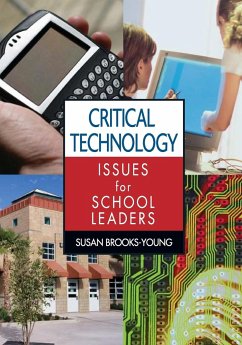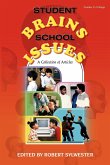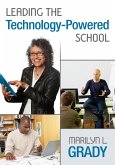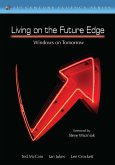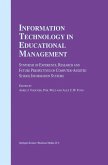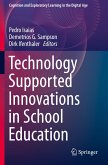Susan Brooks-Young
Critical Technology Issues for School Leaders
Susan Brooks-Young
Critical Technology Issues for School Leaders
- Broschiertes Buch
- Merkliste
- Auf die Merkliste
- Bewerten Bewerten
- Teilen
- Produkt teilen
- Produkterinnerung
- Produkterinnerung
This resource helps school leaders focus on critical technology leadership issues and practical solutions for integrating technology into any school, administration, or professional development program.
Andere Kunden interessierten sich auch für
![Reflective Planning Journal for School Leaders Reflective Planning Journal for School Leaders]() Olaf JorgensonReflective Planning Journal for School Leaders28,99 €
Olaf JorgensonReflective Planning Journal for School Leaders28,99 €![Student Brains, School Issues Student Brains, School Issues]() Robert SylwesterStudent Brains, School Issues36,99 €
Robert SylwesterStudent Brains, School Issues36,99 €![Leading the Technology-Powered School Leading the Technology-Powered School]() Marilyn L. GradyLeading the Technology-Powered School34,99 €
Marilyn L. GradyLeading the Technology-Powered School34,99 €![Living on the Future Edge Living on the Future Edge]() Ted McCainLiving on the Future Edge40,99 €
Ted McCainLiving on the Future Edge40,99 €![Information Technology in Educational Management Information Technology in Educational Management]() VisscherInformation Technology in Educational Management83,99 €
VisscherInformation Technology in Educational Management83,99 €![Developing historical thinking in secondary school students Developing historical thinking in secondary school students]() Begzod HodjaevDeveloping historical thinking in secondary school students22,99 €
Begzod HodjaevDeveloping historical thinking in secondary school students22,99 €![Technology Supported Innovations in School Education Technology Supported Innovations in School Education]() Technology Supported Innovations in School Education74,99 €
Technology Supported Innovations in School Education74,99 €-
-
-
This resource helps school leaders focus on critical technology leadership issues and practical solutions for integrating technology into any school, administration, or professional development program.
Hinweis: Dieser Artikel kann nur an eine deutsche Lieferadresse ausgeliefert werden.
Hinweis: Dieser Artikel kann nur an eine deutsche Lieferadresse ausgeliefert werden.
Produktdetails
- Produktdetails
- Verlag: Corwin
- Seitenzahl: 184
- Erscheinungstermin: 12. April 2006
- Englisch
- Abmessung: 254mm x 178mm x 10mm
- Gewicht: 358g
- ISBN-13: 9781412927307
- ISBN-10: 1412927307
- Artikelnr.: 21761927
- Herstellerkennzeichnung
- Libri GmbH
- Europaallee 1
- 36244 Bad Hersfeld
- gpsr@libri.de
- Verlag: Corwin
- Seitenzahl: 184
- Erscheinungstermin: 12. April 2006
- Englisch
- Abmessung: 254mm x 178mm x 10mm
- Gewicht: 358g
- ISBN-13: 9781412927307
- ISBN-10: 1412927307
- Artikelnr.: 21761927
- Herstellerkennzeichnung
- Libri GmbH
- Europaallee 1
- 36244 Bad Hersfeld
- gpsr@libri.de
Susan Brooks-Young has been involved in the field of instructional technology since 1979. She was one of the original technology users in the district where she taught and has continued to explore ways in which technology can be used to facilitate student learning. She has worked as computer mentor, technology trainer, and technology curriculum specialist. Prior to establishing her own consulting firm, Susan was a teacher, site administrator, and technology specialist in a county office of education in a career that spanned more than 23 years. Since 1986, she has published articles and software reviews in a variety of education journals. She is also author of a number of books which focus on effective use of technology in schools. Susan works with educators internationally, focusing on practical technology-based strategies for personal productivity and effective technology implementation in classrooms. Two current areas of particular interest for Susan are mobile technology and BYOT programs.
Introduction
Part 1: New Literacies
1. Integration Issues for Twenty-First-Century Teachers
2. Information Literacy
3. Visual Literacy: Taking Things at Face Value
4. Library/Media Centers: Strategy for Improved Student Performance
5. Don't Limit the Value of the Library/Media Center
Part 2: Engaging Teachers and Students
6. Implementing Your Vision: Professional Development Through Promoting
Effective Technology Integration
7. Provide Your Own Professional Development
8. Establishing a Web Presence: What to Do Before Building a Classroom Web
Site
9. Set Out on a WebQuest
10. Blogs in K-12 Education: Where's the Fit?
11. Video Streaming: Harnessing a Unique Capability of Technology
12. Distance Learning in the K-12 Learning Environment
13. Project-Based Learning: Technology Makes It Realistic!
Part 3: Providing a Reliable Infrastructure
14. Managing Total Cost of Ownership
15. Tech-Ready Facilities
16. Software and Networks: The New Challenges
17. The Evolving Role of the Technology Coordinator
18. What to Do When Things Aren't Working
Part 4: Legal and Social Concerns
19. Teachers, Students, and Technology Use: Some Cautions
20. Copyright and Technology Use in the Classroom
21. Monitoring Student Internet Use: It's More Than Filtering
22. Spreading the Word Quickly: Technology-Based Home/School Communication
23. Assistive Technologies: Meeting the Needs of Students With Physical
Disabilities
24. Sitting Pretty? The Ergonomics of Computer Workstations
Subject Index
Part 1: New Literacies
1. Integration Issues for Twenty-First-Century Teachers
2. Information Literacy
3. Visual Literacy: Taking Things at Face Value
4. Library/Media Centers: Strategy for Improved Student Performance
5. Don't Limit the Value of the Library/Media Center
Part 2: Engaging Teachers and Students
6. Implementing Your Vision: Professional Development Through Promoting
Effective Technology Integration
7. Provide Your Own Professional Development
8. Establishing a Web Presence: What to Do Before Building a Classroom Web
Site
9. Set Out on a WebQuest
10. Blogs in K-12 Education: Where's the Fit?
11. Video Streaming: Harnessing a Unique Capability of Technology
12. Distance Learning in the K-12 Learning Environment
13. Project-Based Learning: Technology Makes It Realistic!
Part 3: Providing a Reliable Infrastructure
14. Managing Total Cost of Ownership
15. Tech-Ready Facilities
16. Software and Networks: The New Challenges
17. The Evolving Role of the Technology Coordinator
18. What to Do When Things Aren't Working
Part 4: Legal and Social Concerns
19. Teachers, Students, and Technology Use: Some Cautions
20. Copyright and Technology Use in the Classroom
21. Monitoring Student Internet Use: It's More Than Filtering
22. Spreading the Word Quickly: Technology-Based Home/School Communication
23. Assistive Technologies: Meeting the Needs of Students With Physical
Disabilities
24. Sitting Pretty? The Ergonomics of Computer Workstations
Subject Index
Introduction
Part 1: New Literacies
1. Integration Issues for Twenty-First-Century Teachers
2. Information Literacy
3. Visual Literacy: Taking Things at Face Value
4. Library/Media Centers: Strategy for Improved Student Performance
5. Don't Limit the Value of the Library/Media Center
Part 2: Engaging Teachers and Students
6. Implementing Your Vision: Professional Development Through Promoting
Effective Technology Integration
7. Provide Your Own Professional Development
8. Establishing a Web Presence: What to Do Before Building a Classroom Web
Site
9. Set Out on a WebQuest
10. Blogs in K-12 Education: Where's the Fit?
11. Video Streaming: Harnessing a Unique Capability of Technology
12. Distance Learning in the K-12 Learning Environment
13. Project-Based Learning: Technology Makes It Realistic!
Part 3: Providing a Reliable Infrastructure
14. Managing Total Cost of Ownership
15. Tech-Ready Facilities
16. Software and Networks: The New Challenges
17. The Evolving Role of the Technology Coordinator
18. What to Do When Things Aren't Working
Part 4: Legal and Social Concerns
19. Teachers, Students, and Technology Use: Some Cautions
20. Copyright and Technology Use in the Classroom
21. Monitoring Student Internet Use: It's More Than Filtering
22. Spreading the Word Quickly: Technology-Based Home/School Communication
23. Assistive Technologies: Meeting the Needs of Students With Physical
Disabilities
24. Sitting Pretty? The Ergonomics of Computer Workstations
Subject Index
Part 1: New Literacies
1. Integration Issues for Twenty-First-Century Teachers
2. Information Literacy
3. Visual Literacy: Taking Things at Face Value
4. Library/Media Centers: Strategy for Improved Student Performance
5. Don't Limit the Value of the Library/Media Center
Part 2: Engaging Teachers and Students
6. Implementing Your Vision: Professional Development Through Promoting
Effective Technology Integration
7. Provide Your Own Professional Development
8. Establishing a Web Presence: What to Do Before Building a Classroom Web
Site
9. Set Out on a WebQuest
10. Blogs in K-12 Education: Where's the Fit?
11. Video Streaming: Harnessing a Unique Capability of Technology
12. Distance Learning in the K-12 Learning Environment
13. Project-Based Learning: Technology Makes It Realistic!
Part 3: Providing a Reliable Infrastructure
14. Managing Total Cost of Ownership
15. Tech-Ready Facilities
16. Software and Networks: The New Challenges
17. The Evolving Role of the Technology Coordinator
18. What to Do When Things Aren't Working
Part 4: Legal and Social Concerns
19. Teachers, Students, and Technology Use: Some Cautions
20. Copyright and Technology Use in the Classroom
21. Monitoring Student Internet Use: It's More Than Filtering
22. Spreading the Word Quickly: Technology-Based Home/School Communication
23. Assistive Technologies: Meeting the Needs of Students With Physical
Disabilities
24. Sitting Pretty? The Ergonomics of Computer Workstations
Subject Index

